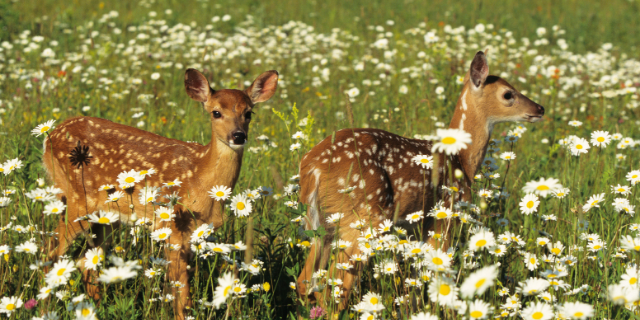10
Mar
Minnesota Deer Threatened by Ubiquitous Neonicotinoid Contamination, According to Study

(Beyond Pesticides, March 10, 2021) Deer populations throughout the state of Minnesota are contaminated with neonicotinoid insecticides, according to preliminary results published earlier this month by the Minnesota Department of Natural Resources (MDNR). Although neonicotinoids are mostly known for contributing to the decline of pollinator populations, like most pesticides brought to market with approval of an inadequate U.S. regulatory review process, there are considerable uncertainties on its impacts after it is released into the environment. As scientists continue to discover novel harms from the use of these systemic insecticides, advocates say it becomes increasingly important to eliminate their use, and take preventive, precautionary measures to ensure similar patterns do not emerge in the future.
MDNR launched its testing project on the state’s deer population in Fall 2019, after a study published by researchers at South Dakota State University found harmful impacts on white-tail deer. The neonicotinoid imidacloprid was found to reduce the body weight and metabolism of white tailed deer and increase the rate of birth defects and mortality in fawns.
The state asked deer hunters to send them the spleens they harvested from wild deer. “We wanted to know if wild deer in natural settings are being exposed to neonics and if certain habitat types had a higher risk,” said Michelle Carstensen, DNR’s wildlife health program supervisor. “Minnesota is a great place to ask this question, as deer are dispersed across the forest, farmland, prairies, and urban landscapes.”
In total, 2,000 people requested sample kits and 800 spleens were collected. Preliminary results reveal that 61% of deer spleen samples contained neonicotinoids. Although MDNR notes that these levels are below allowable levels set by U.S. Environmental Protection Agency (EPA) for consumption of other foods like fruit and beef, it has not yet released exact numbers, and that fact alone does not equate to safety.
Subsequent reporting from the Minneapolis Star Tribune indicates that some of the deer spleens tested contained detections well above levels found in the South Dakota study that result in fawn birth defects (.33 parts per billion). A letter written to hunters who provided MDNR spleen samples informed them that initial testing found levels as high as 6.1 parts per billion.
The detections were not simply from one particular location, but widespread throughout the state, even in remote, forested areas. “How the heck are deer everywhere getting exposed?’ It’s got to be something we’re doing,” said Michelle Carstensen, the wildlife health program supervisor at MDNR, to the Minneapolis StarTribine. Trail cams set up by state agencies had previously recorded birds, deer, and other mammals consuming neonicotinoid coated seeds spilled by chemical farmers. But there’s still uncertainty about whether coated seeds are responsible for such widespread detections.
Reports indicate that MDNR will now send the spleens to the lab for a more detailed work up to determine the exact amount of contamination.
These data reinforce long-standing calls by scientists and conservation groups to eliminate the use of neonicotinoids due to their broad ranging impacts on ecosystems. In 2018, the Task Force on Systemic Pesticides, an international group of over 240 scientists published a Worldwide Integrated Assessment (WIA) synthesizing 1,121 published peer-reviewed studies over the last five years. The scientists found that, “[n]eonics impact all species that chew a plant, sip its sap, drink its nectar, eat its pollen or fruit and these impacts cascade through an ecosystem weakening its stability.”
Neonics harm a range of wildlife, including bees, butterflies, hummingbirds, and other pollinators, songbirds, aquatic species and mammals, including humans. Effects on one species can move up and down food chains and result in phenomena known as trophic cascades. As the WIA notes, this widespread contamination of ecosystems ultimately impacts the services that humans depend upon, including nutrient cycling, food production, biological pest control, and pollinator services.
In order to reverse the harm these chemicals are doing to the natural world, eliminating their use is only the start. Canada and the European Union have banned them completely, while a handful of U.S. states —Vermont, Maryland, Connecticut, and Massachusetts—have imposed restrictions on consumer use. Although local and state efforts should continue, it is past time for the U.S .EPA to take action on this class of insecticides.
As the Biden presidency and EPA begin to draw contrasts with the previous administration by proposing cancelation of highly hazardous pesticides like pentachlorophenol, eliminating neonicotinoid use would send a strong message that the agency is no longer working at the whim of the pesticide industry. Help Beyond Pesticides continue to put pressure on EPA to restore scientific integrity by taking action today. For more information on the wide-ranging effects of pesticides on wildlife, see Beyond Pesticides Wildlife program page.
All unattributed positions and opinions in this piece are those of Beyond Pesticides.
Source: Minnesota Department of Natural Resources, Minneapolis Star Tribune










